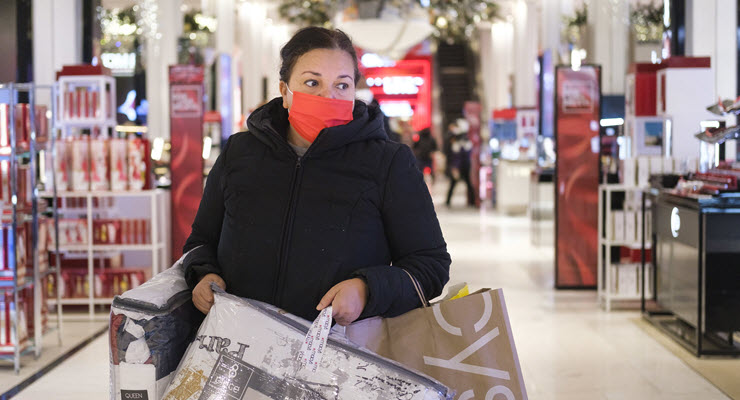
Tear yourselves away from the boasting and gloating over the Morrison government’s mid-year economic update and focus on the latest retail sales data for the US and the final statement for the year from the US Federal Reserve — and start worrying about 2021.
Yes COVID-19 vaccinations campaigns in the United States have started, but there won’t be any impact for months. And yes, the US Congress is finally getting closer to a new, smaller stimulus package of about US$700 billion, instead of the US$904 billion of a week or so ago. They’ll all help.
But a 1.1% slide in November’s retail sales — the second most important month because of the start of post-Thanksgiving sales up to Christmas with “Black Friday” sales — came after a shock revision in October’s 0.3% rise in sales, to a fall of 0.1%.
That means the US economy’s engine (as it is in Australia, Europe and even China these days), household consumption, has fallen into a hole and will struggle to get out without another big boost.
As in Australia there’s still a lot of spare capacity (meaning a large “output gap” between demand and supply) which will keep a lid on prices — but also on wages — for a while. Unlike Australia though, the US has lost control of the virus and is stumbling towards a crisis of surging infections, deaths and no will (thanks to Donald Trump) to tackle it.
And despite a bouncette on Wall Street after the Fed statement was issued — with news of targeted bond buying of up to US$120 billion a month and better forecasts for 2021 — the underlying story from its two-day meeting was that the economy will remain on life support for at least the next two years as this key paragraph again emphasised:
The committee decided to keep the target range for the federal funds rate at 0 to 1/4% and expects it will be appropriate to maintain this target range until labour market conditions have reached levels consistent with the committee’s assessments of maximum employment and inflation has risen to 2% and is on track to moderately exceed 2% for some time.
That means interest rates will be on hold until the end of 2023 at the earliest, and the Fed will ignore all the inflationistas — those lazy analysts and economists who have gone all knee jerk lurch and sent US and other bond market yields higher (the 10-year yield is over 0.9% and approached 1% earlier this month) on some scattered signs of rising costs (mostly from rising oil prices and nothing else).
The Fed made it clear (as indeed the Reserve Bank (RBA)has here to the chagrin of The Australian Financial Review, The Australian and other nests of inflationistas) that it will tolerate higher inflation and will not move rates before an expected rise, but after the rise is clear and sustained.
The RBA is also clear current record low interest rates will remain in place until late 2023 at the earliest.
The Fed’s stance is explained by the detail in November’s retail sales data. The falls in October and November are the first back-to-back drops since the depths of the recession in March and April — which might suggest something about the current weak strength of household consumption in the US.
November’s fall was blamed on new COVID infections and falling household income. Foot traffic in US malls fell 52% on Black Friday (the day after Thanksgiving) — sales were muted in all but food, liquor and hardware (home improvement) sales.
Sales where dealing directly with people also fell: car sales down 1.7%; clothing down 6.8%; cafes, restaurant and bars down 4.0%; appliance sales down 3.5%; furniture down 1.1%; and there were falls for books, music, hobby and sporting goods.
That’s a rerun of March and April, though on a smaller scale.
December and January loom as repeats, according to some US economists. Retail sales, the heart of household consumption, has fallen for two of the three months in the December quarter. No wonder the Fed will keep interest rates as low as possible for as long as possible.








And that, folks, is why it made sense to tackle the pandemic first, rather than delaying and limiting pandemic responses to try an protect business, the economy and employment.
Read somewhere on an online USA media that most of first subsidy went to very big corporations. Small business missed out and millions (yes millions) of people have not received the $1400 promised – some got $400 only. And how late is the 2nd stimulus? A clear case of not enough money floating to consumers means no shopping sprees (even for food). A few YouTube channels had more info on the stimulus. USA is becoming a third world country.
No Walmart or Wally World this year.
Once upon a time, people bought things they needed.
Then “window shopping” mutated into “I want it NOW!”.
Modern retail, as she is spoke, is no better a basis for a functioning society than taking in each others laundry.
Did the last year of shedding all those useless, when not worse, jobs demonstrate that we can live a much better life for a lot less?